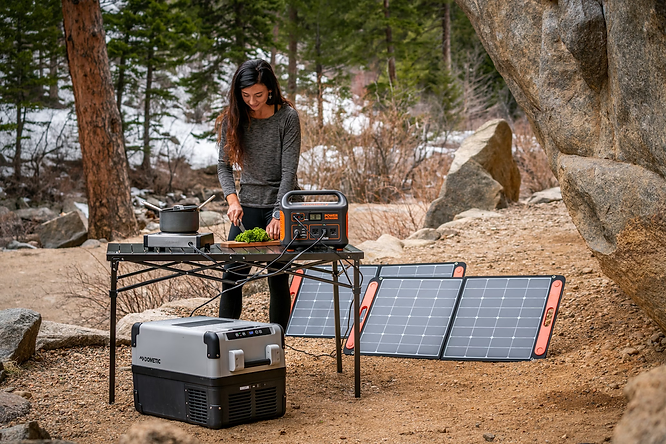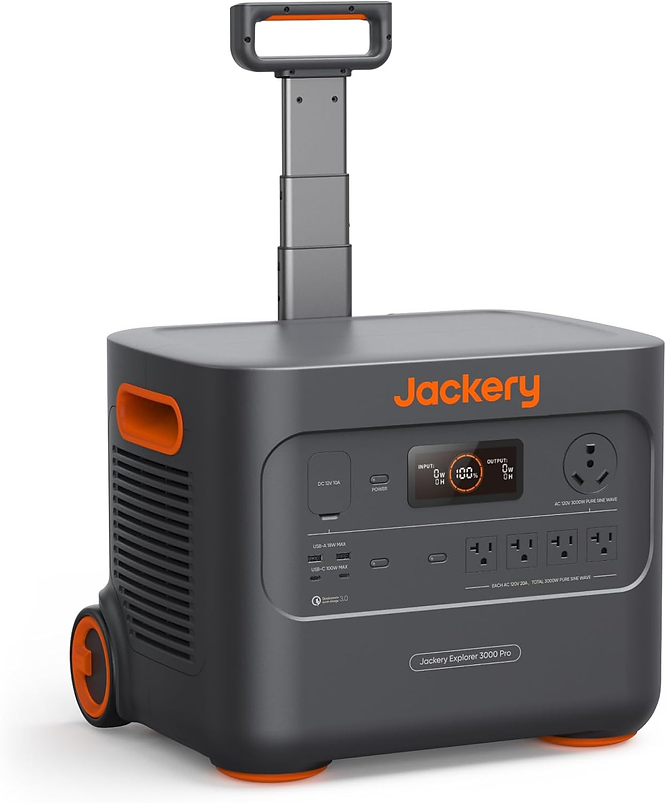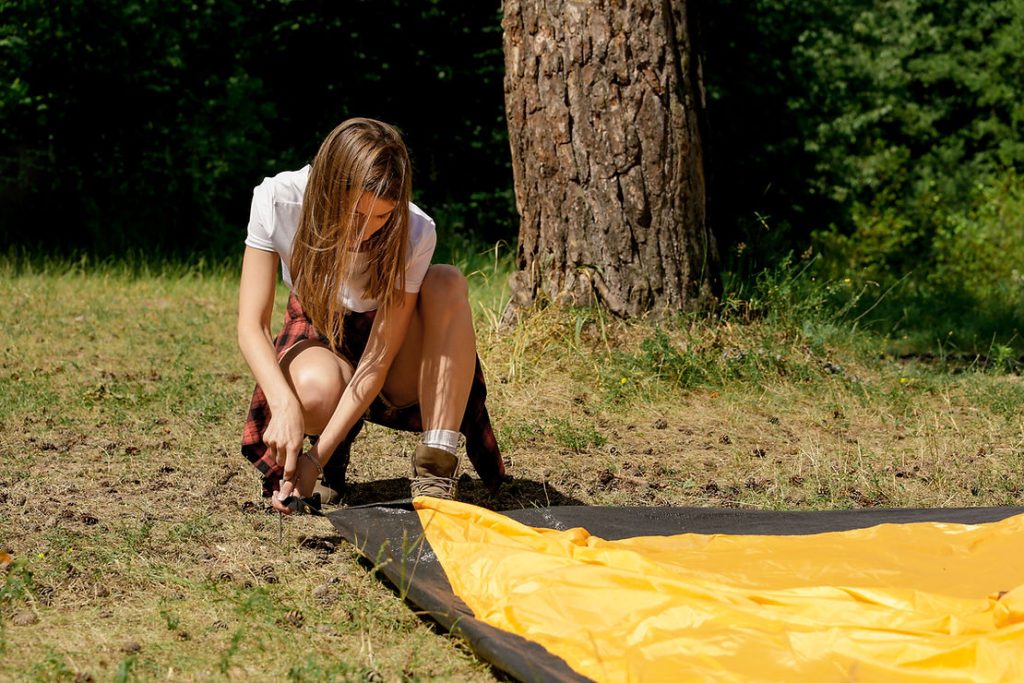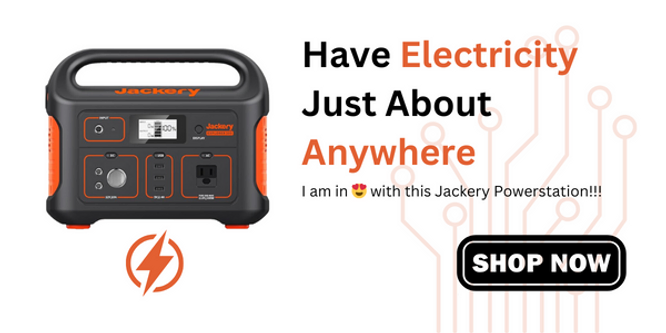For as long as I’ve known about the Jackery, I’ve been obsessed with the idea of owning one. These portable power stations come in a variety of sizes for different uses–making it a little complicated to choose which one to buy.

Heads up: This page contains affiliate links. That means if you click and buy—we may receive a small commission at no additional cost to you. Read more about it here.
- What Features are Important? Capacity | Output | Size | Lifecycle
- Using the Jackery for Lighting
- Using the Jackery for Common Appliances
- Using the Jackery for Heat/Cool Climate Control
- Using the Jackery for Entertainment
- Frequently Asked Questions
Whether you need to power a simple booth set up at a vendor event without relying on a plug-in or you want a solar-powered home backup system, The Jackery has a solution for you. Among the options, the most common uses are for camping and overlapping.
Choosing the Right Model: Attributes
The Jackery comes in at least 5 different models with dozens of different configurations. The Jackery 300 is small and lightweight with a solar panel that is roughly the size of an iPad, making it ultra portable while the 2000 or 3000 are much larger and have more complex accessory setups.

Before getting into the different models, let’s take a look at key differences between models so that you can easily sort out what features are important to you.
Capacity
The capacity of a power bank refers to how much electrical energy it can store and deliver to devices that need charging. This capacity is typically measured in milliampere-hours (mAh) or watt-hours (Wh). A higher mAh value means that the power bank can store more energy and therefore charge devices multiple times before it needs to be recharged itself.
For example, the Explorer 500 which has a capacity of 518kWh can charge a mobile phone 22 times between recharges. Or, it can run a 60W TV for 7.5 hours. This capacity can power a 350W space heater for approximately 1.5 hours. As you combine multiple uses, the capacity becomes increasingly limited.
Pair your Jackery with solar panels and never run out of power
on your next camping trip

Output
The output on a power bank refers to how much power it can deliver to the devices being charged, usually measured in volts (V) and amperes (A). Different devices require different amounts of power to charge efficiently and safely.
For example, a typical USB port on a power bank might have an output of 5V/2A, meaning it delivers 5 volts at a current of 2 amperes. Volts are the ‘push’ and amps are the ‘flow’, together they quantify how much electric energy is present in an exchange.
Some power banks have multiple outputs with different specifications, allowing them to charge several devices simultaneously or support faster charging for specific devices like smartphones or tablets.
Size
The different Jackery models range in size from something the size of a lunchbox to something closer to the size of cooler on wheels. While both ends of the spectrum are portable, the ease of moving them around and the storage space required vary.



I tend to go car camping in my Rav4 most of the time and space is fairly limited. There is no way that I could find the extra room for 1 or 2 of the full-size units. At the same time, the smaller handheld units barely offer enough capacity to provide all the creature comforts that I am accustomed to.
So, compromises have to be made. 👍
Lifecycle
The lifecycle of a Jackery refers to the number of charge and discharge cycles the power bank can go through before its battery capacity significantly decreases. A charge cycle is defined as using 100% of the battery’s capacity, but not necessarily in a single charge. For example, if you use 50% of the battery one day, recharge it, and then use 50% again the next day, that counts as one full charge cycle.
Jackery power banks, like other rechargeable batteries, have a limited number of these cycles before their performance diminishes, typically around 500-1000 cycles. After reaching this point, the battery may not hold as much charge or may deplete faster than when it was new.
In terms of figuring out how long your Jackery will last, if you depleted and recharged your unit every single day, 1000 cycles will last you 2.7 years. For most regular use cases, these units have a reasonable lifespan of 5 years before the battery fails.
In case you are wondering, Jackery does provide warranties that cover their products for 1, 2, or 5 years depending on what you buy and where you buy it.

What Can You Use a Jackery For?
Having the ability to add a little power to your off-grid camping trip opens up the door to new possibilities. But realistically, what can – and what should you use your Jackery Portable Power Station for?
Lights
One of the things that I need the most is a little bit of lighting when I’m camping. Flashlights are pretty good, but they will go dead if you’re using them for ambient light. Using the Jackery to power a set of string lights can be really helpful for the time in between sunset and snooze.
You can run 1 strand of LED string lightson the smallest model, Jackery 300, for 3.9 hours. That’s enough time to cover the time in between when the sun goes down and you go to bed with time to recharge using a solar panel during the day.
When shopping for string lights, look for those that are rated for outdoor use and have minimal power consumption with LED bulbs. The strand I purchased uses 2W per bulb with 30 bulbs on the strand.
While you can run up to 40 strands connected together, each additional bulb adds to the power draw so the only way you will get nearly 4 hours of lighting with your Jackery 300 is if you stick to one strand.
Portable Fridge or Plug-In Cooler
Next to ambient lighting after the sun sets, my next biggest no-electricity challenge is keeping food cold at a consistent temperature for multiple days. Coolers are great, and ice works pretty well, but eventually it melts.
We have invested in better, more insulated coolers to make our ice last longer, and that helps to a point.
We have also enforced strict ‘cooler opening’ rules with our kids and employed the use of these dry bags to protect food items from being submersed in melted ice water.
But when I found out about The Jackery, I thought…yay, we can finally get a portable fridge or plug in cooler and skip the ice altogether.
Even in a compressor-cooled mini fridge plugged into the grid, keeping frozen food frozen is a bit of a challenge so let’s start with the understanding that we’re really talking about keeping food cooled to somewhere between 32 and 40-degrees Fahrenheit.
Mini Fridge
First, a mini fridge comes with its own set of challenges. Power aside, to transport a mini fridge you need to ensure it remains in an upright position or you risk burning the compressor out because the refrigerant and lubricating oil has dispersed. Typically, you would let a refrigerator sit upright for 24 hours after moving it to allow everything to settle.
Most mini refrigerators use between 12W at 60W of power. With a Jackery 1000, you can get 16.9 hours of runtime for an average mini fridge. You’ll need a plan for swapping out your power supply and recharging to keep your fridge running for your entire trip.
Portable Camping Fridge
A portable camping refrigerator solves the ‘has to remain upright while traveling’ problem These units are designed for the “go” but are also considerably more expensive than a standard mini fridge.

This Set Power portable fridge uses between 38W and 50W of power depending on the temperature setting, making it similar in consumption to a mini fridge. While you can power this appliance off a Jackery, you will likely need a larger unit and a plan for swapping banks to accommodate continuous usage.
Appliances
Wouldn’t it be convenient to bring your electric grill, coffee maker, or an ice maker camping with you? Sure, it would…but most household appliances are truly energy hogs. We’re not saying you can’t brew a pot of coffee with a Jackery, we’re saying it might not be the smartest or most efficient use of your power.
Here are a few low-wattage alternatives for common appliances:
- 1000-Watt Electric Grill(most electric grills are 1,600 Watts)
- 800-Watt Coffee Maker (most coffee pots are 1200-1500 Watts)
- 600-Watt Microwave
- 100-Watt Ice Machine
- 100-Watt Cube Fridge
Keep in mind, when choosing a low-watt alternative for these appliances you will also likely notice a decrease in performance over your tried-and-true household favorite appliances. It’s a necessary power-conserving trade-off.
Climate Control
For me, another important power priority is climate control. I live in Arkansas so camping in July and August is pretty much out of the question. I definitely prefer spring and fall to even fringe summer camping trips but even the colder temps vary too much from mid-day to middle of the night to go without any form of comfort-boosting climate control.
I’m talking about using the Jackery to power a heater, portable AC or a fan.

Space Heaters
First, we’re talking about electric space heaters. It’s not safe to use a propane or kerosene space heater in small, indoor spaces. Even relatively small, compact electric space heaters are 1500 watt appliances (like most household appliances).
That’s going to be fairly taxing on most Jackery systems. Even with a Jackery 1000, it’s less than one hour of run time. For off-grid heating options, consider a wood burning stove or a pellet stove with proper venting.
For portable, camping solutions consider electric blankets powered by portable battery packs and cold-weather-rated sleeping bags for overnight use and a Mr Heater Big Buddy Portable Propane Heater or a diesel heater for that climb-out-of-the-bag moment.
Bottom line, an electric space heater and a Jackery portable power station will not keep you warm and toasty all night long.
Electric Pads & Blankets
One of the alternatives that I mentioned above is staying toasty all night long by using an electric sleeping pad or blanket designed to work with a battery pack. You can then recharge your battery pack using your Jackery or a stand-alone solar panel or 12V adapter and your car during the day.
For example, this heated sleeping pad can run for 10 hours on high with a 3000 MAH battery pack. If you can run it on low and stay comfortable, you can get 7 hours out of a 1000 MAH battery pack.
Alternatively, an electric blanket generally uses between 100-150 watts which will yield similar results to the heated sleeping pad outlined above.
Operating a Fan
Fans come in quite a variety of sizes with different power requirements. For portability, we will limit our topic of conversation to tower and box fans. These units can use as little as 10 watts on low speed or as much as 100 watts on high speed.
It all depends on the size and model.
A lightweight, 20-inch box fan with 3 speeds is as simple as it gets. This box fan from Amazon uses 30 watts. That’s a light load compared to most other appliances. Even a modest-sized Jackery unit is going to run a fan like this all day long.
Portable Air Conditioner
Probably no. The problem with portable air conditioners is that they are power hungry and performance light. On average, these units consume around 3,000 watts of power and have mediocre-at-best consumer reviews.
Sure, there are some models out there with energy-efficient ratings that will consume around 700 watts. Those would be in line with other efficient household appliances. But, unlike an AC, you’re not typically running a coffee pot for 6-8 hours straight so the demand on your portable power supply will be different.
A small window AC unit with a cooling capacity of 10,000 BTUs or less, can be slightly more economic on energy consumption ranging between 1,000 and 2,000 watts. Still, this is a significant demand on a portable power supply. If this is even a consideration, you will need to shop the larger capacity models, consider configurations with multiple units, and limit your AC use to the most unbearable stretch of a few hours of the day (generally 2pm-4pm).

Entertainment
If camping is more like glamping for you, entertainment off-the-grid might be a key factor in choosing the right portable power station. With the right Jackery model, you can bring a TV, power your laptop, recharge smartphones, power a radio.
Powering a TV
Most modern TVs range in power consumption from 50W to 200W. Shopping for a smaller screen size with an energy efficient rating can help get your device down to the lower end of that spectrum.
Recharging a Laptop Battery
Most laptop batteries consume 100 watts or less to recharge a battery. How long that battery will last once you’ve charged it, depends on several other factors. But, it’s likely that you know your own electronics. So, plan accordingly.
With that being said, event he smallest Jackery models can keep your laptop powered. For example, with the Jackery 300, you can get at least 3 laptop battery charges out of one power bank charge before you need to reconnect to a power source.
Smart Phones, Bluetooth Speakers & Personal Electronics
Your smallest electronics will take the smallest amount of juice. For smartphones and earbuds, I love the Jackery 100 mini power station! This thing will give you a whopping 66 charges on a pair of airpods or at least 7 charges on an iPhone.

Frequently Asked Questions
Okay, now that we’ve covered the ins and outs of the different Jackery Portable Power Stations, let’s touch base on those lingering questions.
1. Which Jackery Can Power a Coffee Pot?
My home coffee maker of choice is the Ninja Brew Station which pulls 1550W of power to brew a cup or pot of coffee. A standard Black & Decker 12-cup coffee maker pulls 975W of power to heat and brew. In fact, most household appliances will be in the 700-1200W range.
Cuisinart 1-cup coffee maker – 650W
If you insist on a traditional coffee pot, try this one. Although, keep in mind that lower wattage pots tend to make weaker coffee. It just takes more power to get a strong brew. ☕
Mini (1 cup) electric travel kettle – 300W
My preferred method of brewing coffee when traveling (including camping and hotel stays) is by heating water in a mini electric travel kettle and brewing with a french press.
2. Can I Use an Electric Blanket with a Jackery
Yes. Most electric blankets pull 100-150W. Energy consumption will vary based on setting and duration of use. For example, many blankets have a low setting which might use as little as 50W while the high setting on the same blanket might use 200W.
To power an electric blanket on medium for an entire 8-hour night of sleep, you would need a power bank with at least 1,200 Wh. Personally, I like to power my electric blanket with a compact portable power supply and reserve the Jackery for limited-duration draws rather than draining the power over a nights of sleep.
3. Why is the Wattage Rating Important?
When determining if (and how well) you can use a particular electric device with a portable power source, like a Jackery Portable Power Station, there will always be the question of wattage. All power supply’s have a wattage rating and that rating should ALWAYS meet or exceed the wattage requirements of the device.
Wattage quantifies the transfer of energy power. Overloading the wattage rating of a power supply is a serious hazard. Doing so may cause the power supply to overheat, causing damage, failure, or a fire.
Inconsistent or inadequate power delivery resulting from an overloaded power source can look like performance issues, like device that is not running correctly or that shuts down unexpectedly.
Most household appliances draw between 1200 and 1500 watts at peak performance. If you plan to use your Jackery to power common household appliances, like coffee pots, air fryers, and electric cookers, look for a minimum wattage rating of 1500 peak.
If you purchase a Jackery with a lower wattage rating, plan to purchase low-wattage or gas-powered appliances or selectively use your power source so that you will not overload the wattage capacity and burnout your unit.
Ready to Buy? Head Over to Jackery and Shop Today!
Yes, you can buy Jackery Portable Power Stations on Amazon and from other retailers, but when you buy direct from the source, you get the best warranty support.

Need to run 2 sump pumps when power is out
Which model do I need
Hi Judith! First, check the wattage of your sump pumps. Most are between 800-1100 watts. Running 2 of them simultaneously would put you at a draw of 1600 watts. Then consider how long you will need to power them. Since that 2nd question is a bit of an unknown, consider extended outages. If you were to need to cycle between two or more units to provide continuous power for 24H+ with enough time to recharge units between cycles you are probably looking at one of the larger models like the Jackery 5000. See this link for more info: > https://www.jackery.com/pages/reliable-backup-power-during-outages.